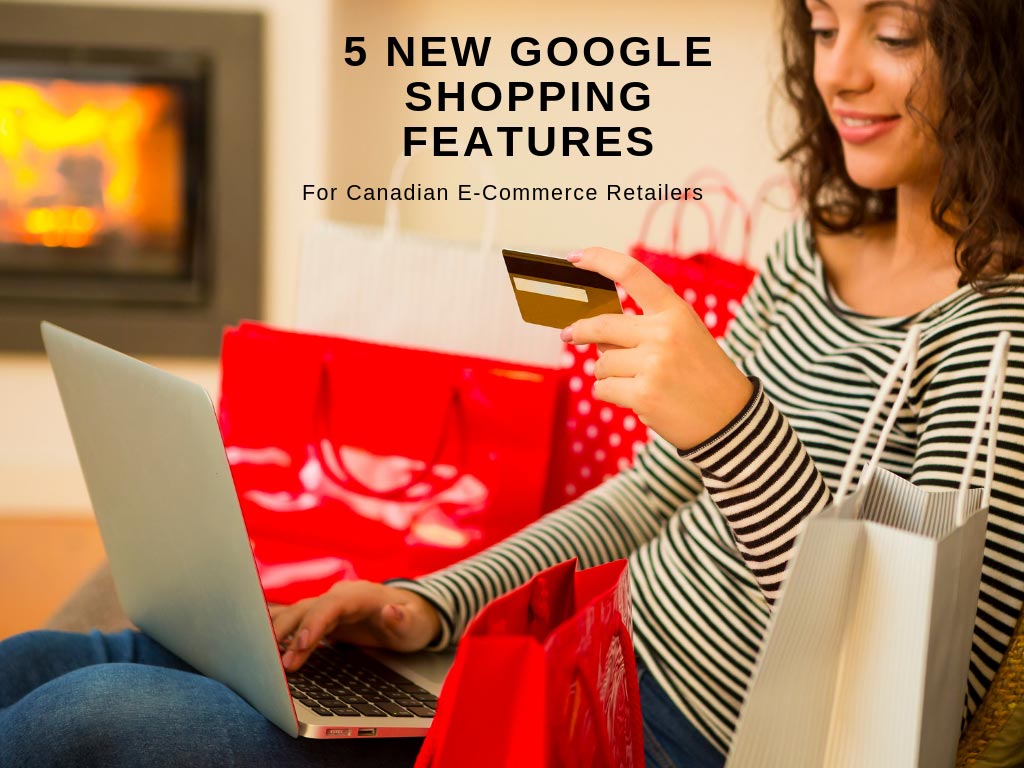5 New Google Shopping Features for e-Commerce Retailers in Canada
We’ve swapped swimsuits for sweaters. Lemonades for pumpkin spice (everything). The snow is here, so now all that’s left is…. shopping season! Black Friday, Cyber Monday, extended Black Friday, pre-Christmas, last-minute deals, Boxing Day, year-end clearances – there seems to be an unlimited number of opportunities for sales.
Nowadays we don’t even have to move from our couch to shop the deals, thanks to e-commerce. According to Canada Post, 80% of Canadians have shopped online in the past year, making almost 11 purchases per year on average with an average value of $101 per purchase. Stats Canada numbers from 2017 show that in 2017 the revenue from Canadian e-commerce stores was estimated at $15.7 billion. This cannot be ignored!
If you already have e-commerce set-up on your site, you’re already a step ahead. Have Google Shopping ads too? You’re on the ball! But there’s always something new coming up, and we’re here to share some new ideas on how to get the most of out your current Google Shopping campaign for this year’s shopping season. But before we dive into the innovations in Google Shopping this year, let’s do a quick refresher.
Google Shopping Basics
Did You Know? Google Shopping started in the early 2000s and was once called ‘Froogle’. The purpose of the service was to provide free product listings and price comparisons and users could discover various products offered by different vendors, sort and filter them, and then make a purchase. Now, Froogle is called Google Shopping.
Google Shopping is powered by two platforms:
- Google Merchant Center
- Google Ads
The Google Merchant Centre is critical to the success of any Shopping campaign. It’s the product feed you upload to Google Ads, so making sure everything is configured and set-up properly will ensure your product information, pricing, and availability is accurate when you run your campaign. The last thing you want to advertise is something that’s out of stock! This process can take a while, which is why it’s good to a) start early and b) turn to experts like Vovia to help with the process.
Once your product feed is good to go (and if it takes a few tries, that’s completely normal), you can link your Merchant Center account with your Google Ads account. Then, you can start writing your ads for the products you’re selling. For some more best practices on how to build a strong Google Shopping campaign, see our post from earlier this year.
Of course, nothing ever stays still with digital marketing, and Google has released many new features since last year’s post. So, what can you do to make the most of this shopping season? Let’s take a look at some new features and ad formats for Google Shopping to give your e-commerce business the edge.
What are the Latest Innovations in Google Shopping?
Leveraging machine learning to free up your time. Most of Google’s feature updates this year have involved the ever-so-buzzworthy-concept, machine learning (such as machine learning attribution, Smart Bidding, and Smart Display). For Google Shopping, a feature called Goal Optimized campaigns use machine learning to discover trends in your data that takes a lot of mundane time and effort for humans to complete. You can set the campaign to maximize conversion value and even specify a certain return on ad spend (ROAS). It takes some time for the machine to learn, but it will start to understand which searches are likely to lead to a purchase and show up for those more often. This gives marketers like us more time to focus on things that still need a human touch, like product strategy, brand messaging, and managing your product feed.
Your Catalog, on Display! A new ad type called Local Catalogue ads, while not technically a Shopping ad, does leverage your Merchant Centre feed to create a Display ad that looks like a mini-catalogue. Taking a similar approach to Facebook Carousel, it showcases in-stock products in a little feed that users can browse directly from the ad unit. This is a great feature to complement printed campaigns – including catalogs and flyers – with the added audience and measurement benefits of digital ads.
Get ‘em While They’re Close. Yes, people still do go out to stores to buy things, and with Local Inventory Ads, you can target them on their phone with products that are in-stock near them. When shoppers click your ad, they arrive on a Google-hosted page for your store. This is called the ‘local storefront’. Shoppers can use the local storefront to view in-store inventory, get store hours, find directions, and more.
Price Comparing Isn’t Just for Consumers. Google Ads reporting will be available soon to show Shopping advertisers how other retailers are pricing the same products. You can use these pricing insights to inform your bidding strategy when you have price-competitive products to promote, to influence pricing strategy with your merchandising teams, or to troubleshoot performance drops due to competitors’ pricing.
Shopping Extensions for YouTube. Unboxing videos are very popular nowadays, giving people inspiration to buy. Yet another great opportunity for a shopping ad! In June, Google announced that you can add an affiliate location extension to your existing YouTube ad. For example, do you carry your products at local third-party retailers? When a user clicks on your ad, they can see nearby locations where your product is in stock.
With a handful of new Google Shopping tricks up your sleeve, you’ll be ready to tackle the most wonderful time of the year! Need some help with your campaign? Give us a shout!
